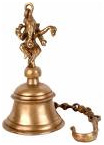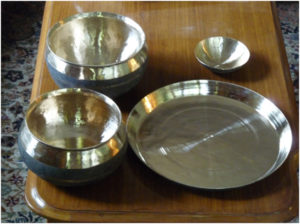KANSA or BELL METAL
In Odiya Bell-Metal is known as Kansa. The craftsmen were called ‘Kansari’. Kansa is a type of Bronze with a higher tin: copper ratio. Kansa does not tarnish like copper or brass. The Kansa when struck generates a ringing tone for several seconds. That’s why it is called Bell Metal in English. It is used to make Ghantis (prayer bells), Ghantas (Call to prayer bell) and Kartals (hand cymbals) that are used during kirtans. Kansa is a good conductor of heat and retains heat well. The inside surface is hand-coated with tin (Kalai). It was used to make Degchis (the most common cookware) and Paraat (to knead dough for making bread).
 Bell-metal is most attractive with its soft surface and golden tint. A very ancient metal, it is costlier and requires great skill on the part of the craftsman as each object is shaped by hammering the hot metal lump into delicate and beautiful forms. The inside is then polished to give it a golden glow, the outside is often left dark. Bell- metal plates, tumblers and bowls never tarnish or react to weak acids like citrus fruit and are longer lasting than steel. The rich golden colour improves with age and food stored in it remains fresh and hygienic for a long time. Ayurveda recommends serving and eating in Kansa. A unique feature of Bell-metal products from Kantilo is that right from the making of the alloy to the finished product; everything is done under one roof by a group of three or four craftsmen.
Bell-metal is most attractive with its soft surface and golden tint. A very ancient metal, it is costlier and requires great skill on the part of the craftsman as each object is shaped by hammering the hot metal lump into delicate and beautiful forms. The inside is then polished to give it a golden glow, the outside is often left dark. Bell- metal plates, tumblers and bowls never tarnish or react to weak acids like citrus fruit and are longer lasting than steel. The rich golden colour improves with age and food stored in it remains fresh and hygienic for a long time. Ayurveda recommends serving and eating in Kansa. A unique feature of Bell-metal products from Kantilo is that right from the making of the alloy to the finished product; everything is done under one roof by a group of three or four craftsmen.
Kansari artists work before sunrise due to the great amount of heat produced through the crafting process which prevents them from working on warm days. The process is so labor intensive that about four craftsman work on one piece. They begin by mixing the metals together and working them into ingots, which are then heated until they become malleable. After this, the mix is beaten with a hathoda (hammer) into the desired shape for the intended design.
 This process of manufacture and the items derived from it date back to the Charaka Sanhita written around 400 A.D. Through the ages, the craft persons of Kantilo specialised in manufacturing utensils using the formula of Charaka, a famous Ayurvedic scientist who determined the proportion of copper and tin to be mixed to produce the alloy. In Odisha, metal crafts were patronised and encouraged by kings during the 11th century for decorative use in their palaces, temples and in social rituals.
This process of manufacture and the items derived from it date back to the Charaka Sanhita written around 400 A.D. Through the ages, the craft persons of Kantilo specialised in manufacturing utensils using the formula of Charaka, a famous Ayurvedic scientist who determined the proportion of copper and tin to be mixed to produce the alloy. In Odisha, metal crafts were patronised and encouraged by kings during the 11th century for decorative use in their palaces, temples and in social rituals.
Kansa and Kantilo
Kantilo is a small town on the banks of the mighty Mahanadi river in Nayagarh district of Odisha, It is home to the magnificent temple of Lord Nilamadhaba, who according to legend is one of the earlier forms of Odisha’s presiding deity Lord Jaganath. In this original form, the presiding deity of Orissa was worshipped at Kantilo, a primordial God, by Sabaras, a Pre-Aryan and Pre-Dravidian tribe of the Austral linguistic family. The name Kantilo is derived from a berry Kantei, which grows on a thorny bushy plant found in the nearby hills. Located near the confluence of three rivers-Mahandi, Kuanria and Kusumi the temple structure is like the Jagannath temple of Puri.
Biswabasu the local Sabra Chief worshipped Kitung, whose image was in a small cave close to the river. According to the Puranas, the deity was originally worshipped in the form of a black tong image know as ‘Nilamadhaba’, (The wooden image came much later). According to myth, Nilamadhaba appeared in a dream of Indradyumna, the legendary King of Malwa. To see the God, the king consulted his pandits who informed him that the Nilamadhaba was being worshipped somewhere in the forest of Utkal. He deputed his courtier Bidyapati, to trace out the God. After walking bare foot for several days through the thick forest of hill tracks along Mahanadi Bidyapati finally landed in the domain of Biswabasu. He failed to learn much about Lord Nilamadhaba, but fell in love with Lalita, the tribal chief’s daughter and with the blessings of her father married her.
One night, Lalita confided in her husband the fact that her father worshipped Lord Nilamadhaba in a cave deep inside the forest. Bidyapati was forced back into mission mode and beseeched her to take him there. She agreed, but on one condition that Bidyapati would have to go there blind folded.
On the day of reckoning, he carried a handful of mustard seeds which he kept dropping on the way at regular intervals. The advent of monsoon saw the mustard plants form the path leading right up to the cave. Soon after Bidyapati went back to Malwa and narrated his experience to King Indradyumna. An immediate decision to invade was taken. But while on his way, he was told by a divine voice that Nilamadhaba had disappeared and was floating in the sea. The king was forced to seek Biswabasu’s assistance who agreed with great magnanimity (even pardoning his son-in-law) and agreed to come to Puri.
There the floating divine image behaved like a log of wood and came ashore. The idols of Lord Jagannath and others were made out of that log and placed in a tiny temple. The present one at Puri came up sometime in the 12th Century. One interesting fact is that the word, juggernaut is derived from Lord Jaganath when Britishers witnessed the force of his hand drawn chariot during the annual Rath Yatra (nothing to do with L.K ji and others who followed him !!) Of course they could not get the pronunciation right!!

WE ARE TAKING ORDERS, BUT PLEASE NOTE THAT IT WILL TAKE AROUND 30 DAYS BEFORE DELIVERY IS MADE. ALSO WE WOULD REQUEST YOU TO PROVIDE US WITH A 50% ADVANCE BY CHEQUE/CASH (CHEQUES IN THE NAME OF ATMASHAKTI)
| Kansa Price List as on March 2022 | |
| Sr. No. | Items |
| 1 | Large dongas are 7″ diameter and weigh around 850 grams costing each at Rs.3100/- |
| 2 | Medium dongas are 6.5″diameter and weigh around 750 grams costing each at Rs.2700/- |
| 3 | Small Dongas are 6″ diameter and weigh 675 grams costing each at Rs.2400/- |
| 3 | Smallest Donga weigh 400 grams costing each at Rs.1600/- |
| 4 | Katoris weigh 170 grams costing each at Rs.780/- |
| 5 | Glass Big weigh 432 grams costing each at Rs.1500/- |
| 6 | Glass Medium weigh 386 grams costing each at Rs.1400/- |
| 7 | Glass Small weigh 354 grams costing each at Rs.1600/- |
| 8 | Spoon weigh 36 grams costing each at Rs.165/- |
| 9 | Ice Cream Set- Small Katoris weigh 100 grams costing each at Rs. & Spoon Small weigh 20 grams (Rs.550) |
| 10 | Side Plates weigh 322 grams costing each at Rs.1200/- |
| 11 | Thalis weigh 836 grams costing each at Rs.3000/- |
| 12 | Thalis weigh 800 grams costing each at Rs.2900/- |
| 13 | Thalis weigh 672 grams costing each at Rs.2400/- |
